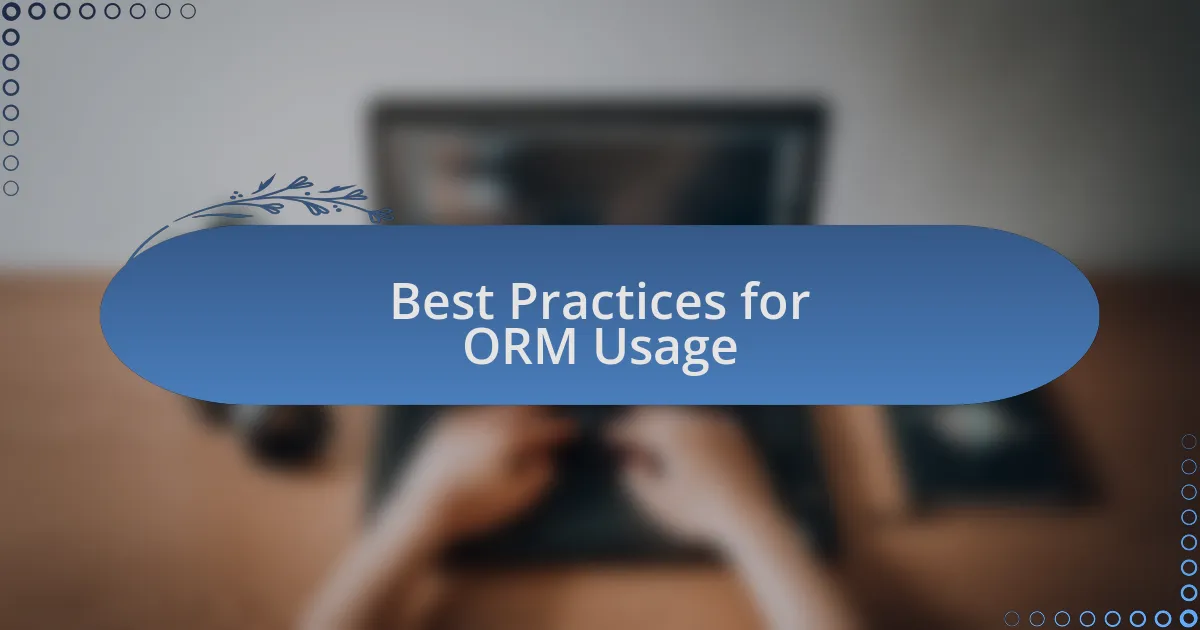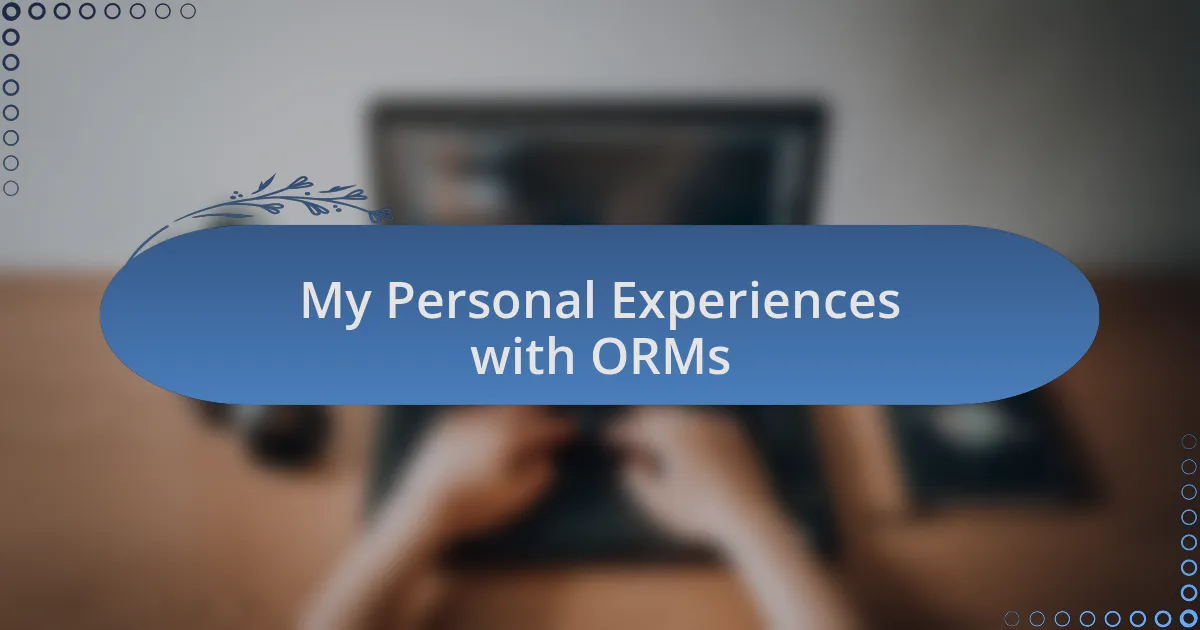Key takeaways:
- ORMs simplify database interactions by allowing developers to manipulate data as objects, enhancing productivity and reducing the complexity of SQL queries.
- They improve code maintainability and collaboration among teams, making it easier for developers to contribute without extensive database knowledge.
- Key challenges include performance overhead, debugging complexity, and the learning curve associated with ORM tools, necessitating a balance between abstraction and optimization.
- Best practices for ORM usage include keeping queries simple, regularly testing generated SQL, and maintaining clear model relationships to ensure application performance.

Understanding ORMs in Web Development
ORMs, or Object-Relational Mappers, act as a bridge between programming languages and databases, transforming complex interactions into simpler, more manageable code. When I first encountered ORMs in a project, it felt like discovering a powerful tool that streamlined my workflow, making database operations feel almost intuitive. Have you ever struggled with the tediousness of writing SQL queries? With ORMs, you can work with database records as if they are regular objects in your programming language.
One of the standout advantages of using ORMs is the abstraction they provide, allowing developers to focus more on the application logic rather than database intricacies. I remember a time when I made a small mistake in a hand-written SQL query that cost me hours of debugging. If I’d been using an ORM, I could have simply modified the object properties and let the tool handle the SQL generation. Does that resonate with your own experiences in development challenges?
Additionally, ORMs can enhance maintainability in web applications by promoting cleaner code. I’ve often noticed that projects with well-integrated ORMs are not only easier to read but also more adaptable to changes. Can you recall an instance where switching to an ORM saved you time? It’s these little efficiencies that can make a huge difference in long-term project success.

Benefits of Using ORMs
One of the significant benefits of using ORMs is the time they save on database queries. I vividly remember a project where, instead of crafting complex SQL queries, I could retrieve data through simple method calls. It was almost liberating to realize that I could focus on building features rather than getting bogged down in the intricate details of data retrieval. Have you had a similar experience where a tool suddenly made your workload lighter?
Another advantage is the increased portability of code across different database systems. I once worked on a project where we migrated from one database to another, which would have been a nightmare without an ORM. The transition was smooth—most of the code remained intact, and I didn’t have to rewrite every query. It’s moments like these that make me appreciate how ORMs can adapt to changing technological environments, don’t you think?
Lastly, using ORMs can foster a better collaboration among team members. I recall when I joined a project that had a well-established ORM layer; even newcomers could contribute without needing extensive database knowledge. This shared understanding of data models allowed for faster ramp-ups and greater productivity. Isn’t it empowering to think that a tool can pave the way for better teamwork and collective success?

Common ORM Tools and Frameworks
When it comes to popular ORM tools, Entity Framework stands out in the .NET community. I remember diving into a project that utilized Entity Framework, and I was impressed by how it seamlessly integrated with C#. This framework allowed me to connect to the database without losing sight of the object-oriented principles, making my code cleaner and more maintainable. Have you ever found yourself enjoying a tool so much that it changes the way you think about coding?
On the other hand, if you’re working with Python, Django’s ORM is hard to beat. There was a time when I built a web application using Django, and I appreciated how effortlessly it managed related data through its models. It felt almost magical to define relationships without having to write a single line of SQL. I still recall the rush I felt when I realized I could focus entirely on logic rather than the mechanics of database interactions; it definitely redefined my approach to web development.
Of course, let’s not forget about SQLAlchemy, which offers flexibility and power for Python developers who want to choose their own database engine. I had an experience where I created complex queries using SQLAlchemy’s expression language, and it was rewarding to see how cleanly I could structure them. This experience made me realize that, when using the right tools, the learning curve becomes an exhilarating journey rather than a daunting task. Have you explored different ORMs and found one that resonates with your workflow?

Best Practices for ORM Usage
When utilizing ORM tools, one of the best practices is to keep your queries simple and efficient. I remember a time when I over-complicated a data retrieval process because I wanted to show off the ORM’s features. The result? A sluggish application that frustrated end-users. Have you ever over-engineered a solution, only to realize that simplicity often leads to better performance?
It’s also important to regularly test and optimize your generated SQL queries. During a project, I once found that the ORM I was using generated inefficient queries for a major data fetch. By digging into the ORM’s capabilities, I learned how to tweak configurations, which drastically improved load times. This experience taught me that understanding what’s happening “under the hood” can be just as crucial as working within the ORM’s comfortable interfaces.
Lastly, I advocate for maintaining clear relationships between your models. There was this time I neglected proper indexing while using an ORM for a large dataset, and the application slowed to a crawl. It reminded me that properly defining your relationships not only keeps your code organized, but also empowers the ORM to manage data more effectively. Are you proactively thinking about how the structure of your data impacts your application’s performance?

Challenges in ORM Implementation
Transitioning to implementing ORM can be difficult due to the steep learning curve associated with understanding its concepts and functionality. I recall diving into ORM for the first time and being overwhelmed by the different annotations, configurations, and frameworks available. It felt like I was trying to learn a new language overnight—have you ever faced that moment when you feel lost in the vast possibilities?
Another challenge is managing the performance overhead that comes with ORMs. Early in my career, I experienced a project where our reliance on ORM abstraction led to hidden performance pitfalls. I still remember the sinking feeling when our application’s response times shot up because the ORM was generating suboptimal queries. This reinforced the importance of balancing convenience with performance; sometimes, I find it necessary to write raw SQL for critical operations just to keep the performance in check.
Lastly, debugging can become a nightmare if ORM-generated queries go awry. There was a particular instance when I had to sift through layers of abstraction to pinpoint the source of a bug caused by an unexpected join. It was frustrating, and I found myself yearning for the straightforwardness of writing queries without an ORM. Have you ever wished to peel back the layers and see exactly what’s being executed? This realization often leads me to appreciate the trade-offs between speed of development and ease of troubleshooting.

My Personal Experiences with ORMs
Using ORMs has been a transformative experience for me, especially when I think about the speed and efficiency they offer. I remember a project where I integrated an ORM for the first time; it felt like unlocking a treasure chest of tools that made data manipulation more intuitive. It was a little like discovering a shortcut in a familiar neighborhood—suddenly, I was able to focus on building features rather than getting bogged down by SQL syntax.
However, I did hit some bumps along the way. There was a period when I relied too heavily on the ORM’s default settings, which led to some confusing bugs. I vividly recall the moment when I ran a migration and, to my dismay, an entire dataset was duplicated—talk about a headache! That situation taught me the crucial lesson of not just trusting the ORM blindly but understanding its behavior deeply. Have you had moments where you relied too much on a tool and learned the hard way?
On the flip side, I’ve also experienced the joy of seeing ORMs streamline complex querying, especially in collaborative environments. Working with a team on a multi-faceted application, the ability to easily share models and relationships significantly enhanced our workflow. I found that this collective adaptability fosters creativity—like a symphony where everyone plays their part seamlessly. Do you remember a time when a tool made teamwork not just easier but also more enjoyable? These moments remind me why I continue to explore ORMs, even amidst their challenges.

Tips for Effective ORM Utilization
Utilizing ORMs effectively relies on understanding their nuances. Early in my career, I disregarded optimization, leading to slow application performance. This was a wake-up call—having spent countless hours fixing issues, I realized that diving into the ORM’s configuration options was non-negotiable. Have you ever experienced a project stall because you skipped over the fine print?
Another key tip is to embrace the power of migrations. I still remember a project where I neglected to version my schema changes. It became nearly impossible to troubleshoot issues later. From that point on, I made it a habit to run migrations diligently, treating them like my roadmap to ensure a smooth development journey. You’re probably wondering how crucial migrations are in maintaining project stability, right?
Lastly, building a robust testing suite around your ORM interactions can save you considerable headaches. Once, I had a faulty query that slipped through the cracks during a critical update. Because I lacked thorough tests, it cost me valuable time and resources to identify the fault. Incorporating automated tests now feels like a safety net—ensuring my application runs smoothly before I hit deploy. Can you think of times when good testing practices saved your projects from potential pitfalls?